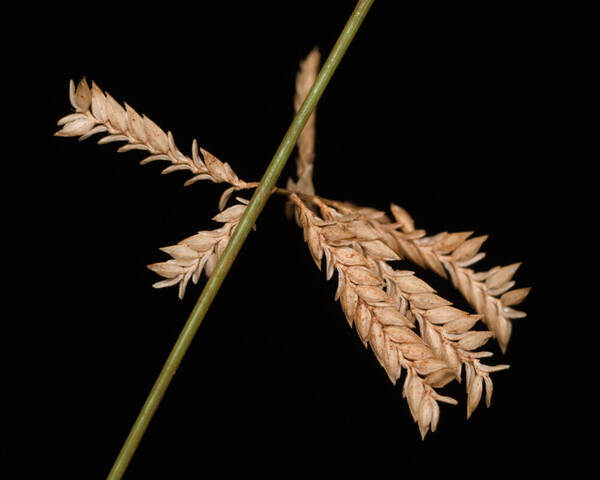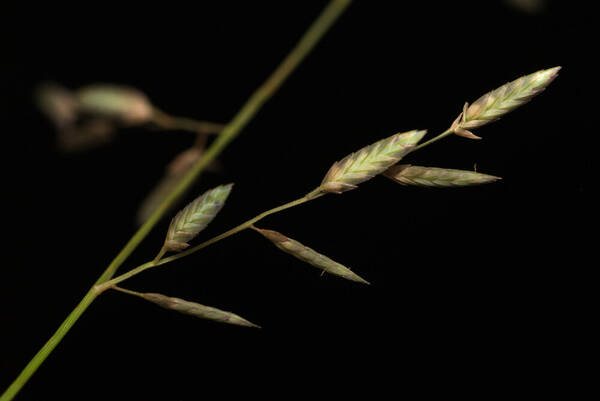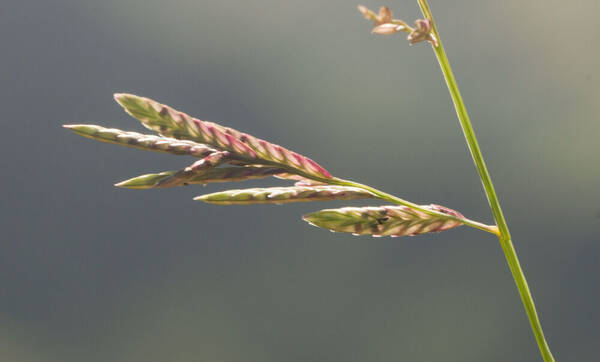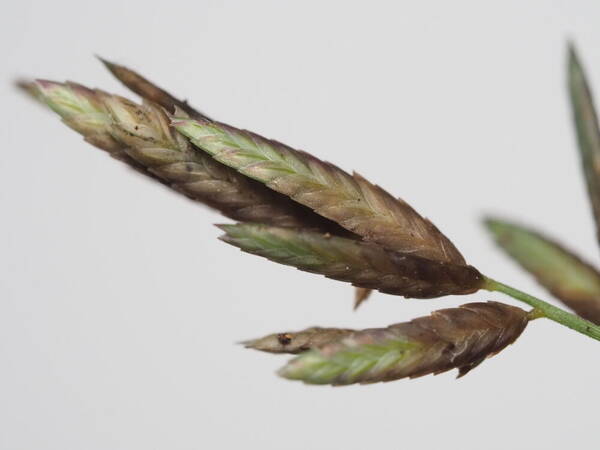Info
Subfamily: Chloridoideae
Genus etymology: Eragrostis = "love grass" [Greek] unclear origin, other etymologies such as "early grass" or "very grass" have also been speculated
Species etymology: brownii = honorific for Robert Brown [1773-1858]
Photosynthetic type: C4 (warm season)
Nativity: naturalized - intentional
First recorded in Hawaiʻi: 1916
Map


Inflorescence








Plant


Habit

Spikelets












Description
Habit: Perennial; caespitose. Culms erect, or geniculately ascending; 15-50 cm long. Leaf-sheaths 3-4 cm long. Leaf-sheath oral hairs ciliate. Ligule a fringe of hairs; 0.2 mm long. Leaf-blades 10-25 cm long; 1-3 mm wide. Inflorescences: Inflorescence a panicle. Panicle open; ovate; 5-15 cm long; contracted about primary branches. Primary panicle branches ascending; 1 -nate; 2-7 cm long. Panicle branches stiff; scaberulous. Spikelets ascending, or spreading; solitary. Fertile spikelets pedicelled. Pedicels 1-2 mm long. Spikelets: Spikelets comprising 10-15 fertile florets; with diminished florets at the apex. Spikelets oblong; laterally compressed; 4-5.5 mm long; 1.6-2 mm wide; breaking up at maturity; rhachilla persistent; retaining paleas; fragile above, or becoming fragile after lemmas shed; with the distal florets disarticulating separately. Fertile Spikelets: Spikelets comprising 10-15 fertile florets; with diminished florets at the apex. Spikelets oblong; laterally compressed; 4-5.5 mm long; 1.6-2 mm wide; breaking up at maturity; rhachilla persistent; retaining paleas; fragile above, or becoming fragile after lemmas shed; with the distal florets disarticulating separately. Glumes: Glumes deciduous; similar; shorter than spikelet. Lower glume ovate; 1-1.7 mm long; 1 length of upper glume; membranous; 1-keeled; 1 -veined. Lower glume lateral veins absent. Lower glume apex acute. Upper glume ovate; 1.5-1.7 mm long; 0.5 length of adjacent fertile lemma; membranous; 1-keeled; 1 -veined. Upper glume lateral veins absent. Upper glume apex acuminate. Florets: Fertile lemma ovate; 1.7-2 mm long; chartaceous; keeled; 3 -veined. Lemma apex acute. Palea keels scabrous. Apical sterile florets resembling fertile though underdeveloped. Fruits: Caryopsis with adherent pericarp; ovoid; 0.7 mm long; red. Distribution: Asia-temperate: China. Asia-tropical: India, Indo-China, Malesia, and Papuasia. Australasia: Australia and New Zealand. Pacific: southwestern, south-central, northwestern, and north-central.
(Description source: Clayton, W.D., Vorontsova, M.S., Harman, K.T. and Williamson, H. (2006 onwards). GrassBase - The Online World Grass Flora. Available at https://powo.science.kew.org )
Perennials; culms tufted, decumbent to prostrate, sometimes erect, 1.5-5(-8) dm tall. Leaves primarily crowded toward base of culms; sheaths 3-4 cm long, pilose at throat, otherwise glabrous, margins membranous; ligule ciliate, ca. 0.2 mm long; blades flat, 10-25 cm long, 1-3 mm wide, glabrous. Inflorescences paniculate, 5-15 cm long, branches widely spaced, ascending to spreading, usually with 1 branch per node, branches 2-7 cm long, axils glabrous, the main axis and branches scabrous; spikelets 10-15-flowered, widely spaced, appressed, compressed, 4-5.5(-7) mm long, 1.6-2 mm wide, pedicels up to 1 mm long, rachilla disarticulating; glumes subequal, (1-)1.5-1.7 mm long, 1/2 the length of the lowest pair of florets, glabrous, margins hyaline, apex acute; lemmas closely imbricate, 1.7-2 mm long, ca. 0.7 mm wide, 3- nerved, glabrous, apex acute; palea slightly shorter than lemma, persistent, keel scaberulous. Caryopsis dark red, ovate, ca. 0.7 mm long. [2n = 40.]
(Description source: O’Connor, P.J. 1990. Poaceae, pp. 1481–1604. In: Wagner W.L., Herbst D.R. & Sohmer S.H. (eds.)., Manual of the flowering plant of Hawaiʻi. Vol. 2. University of Hawaii Press & Bishop Museum Press, Honolulu )